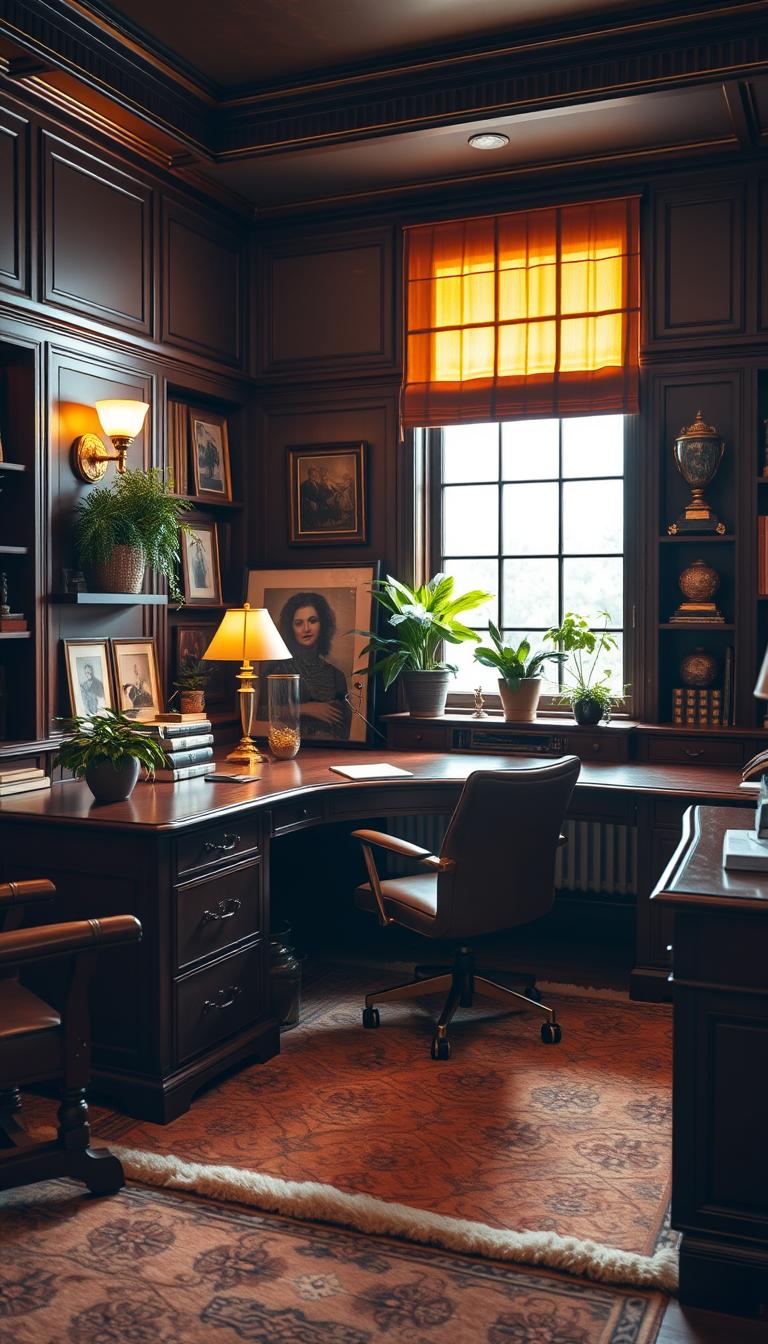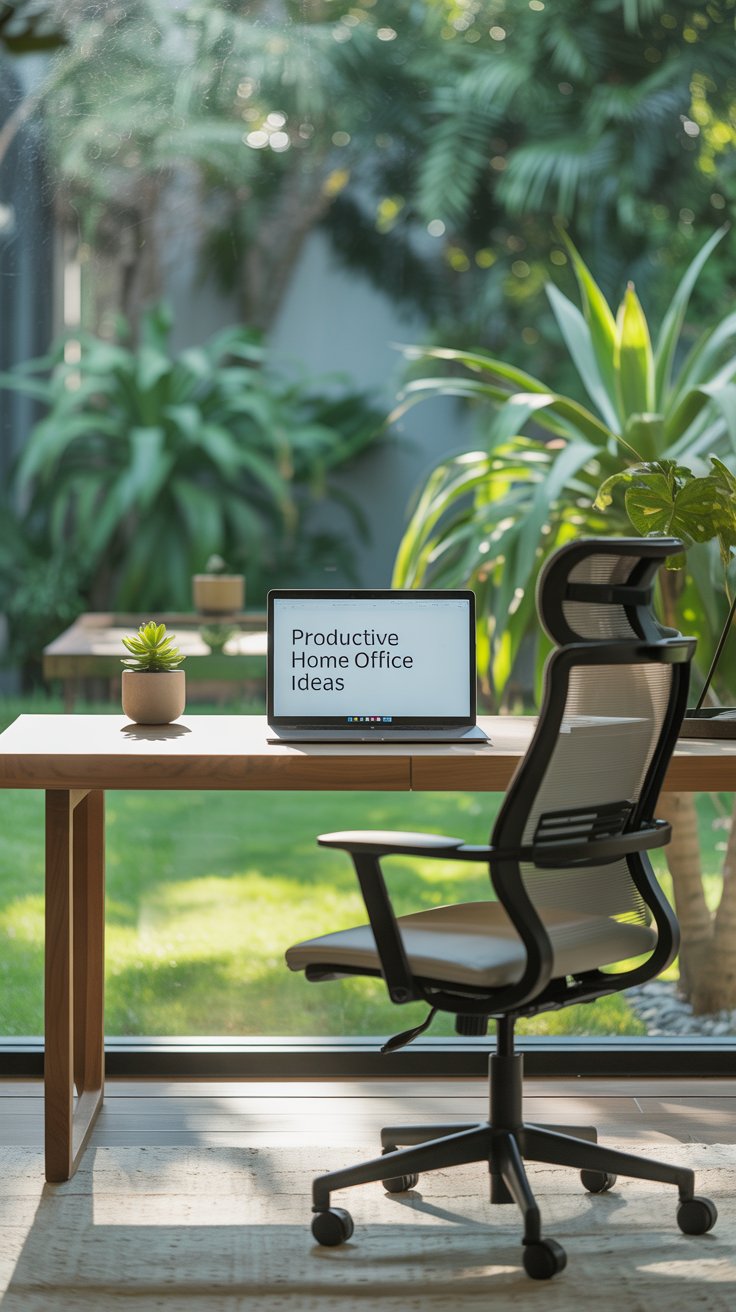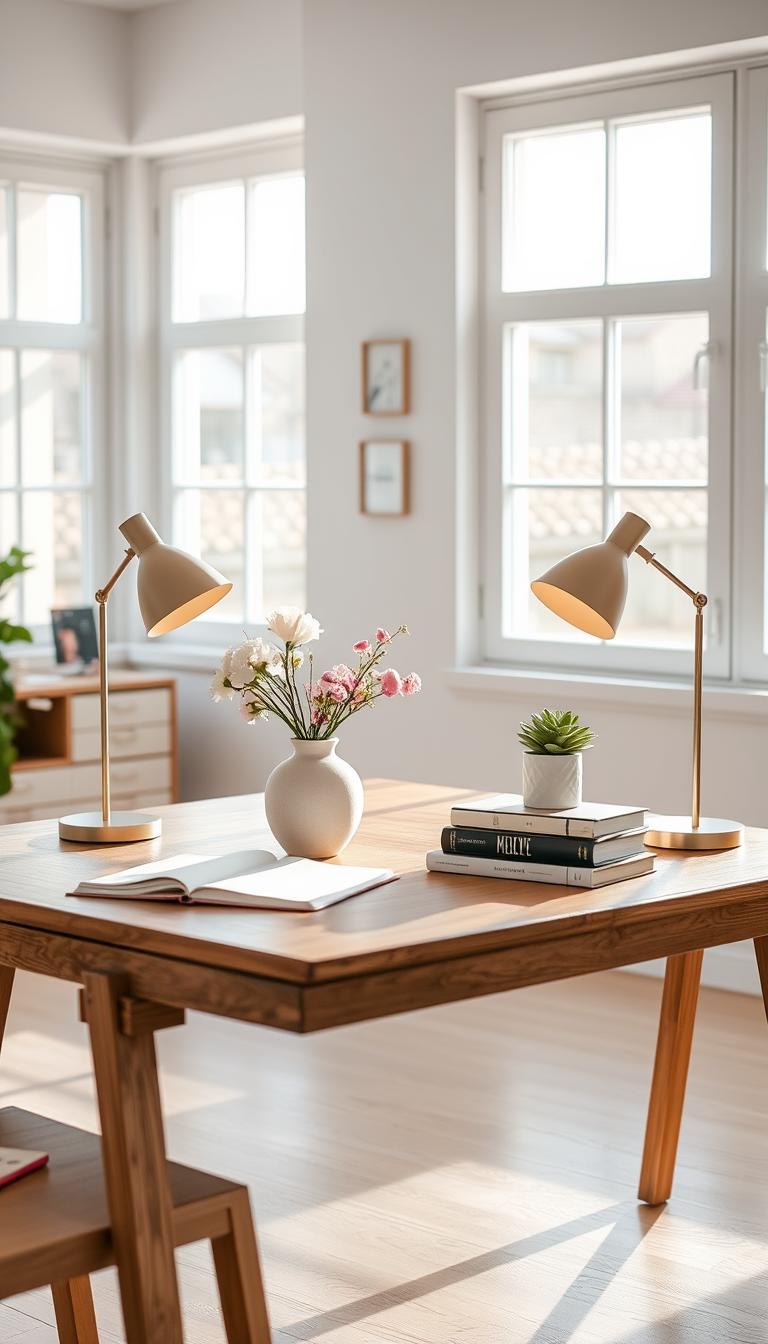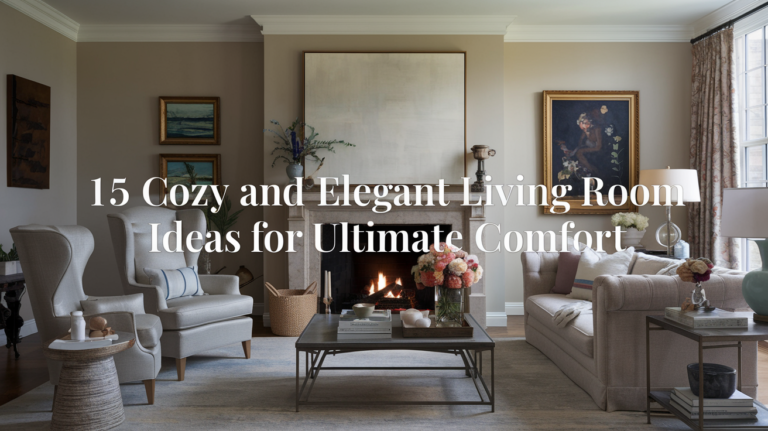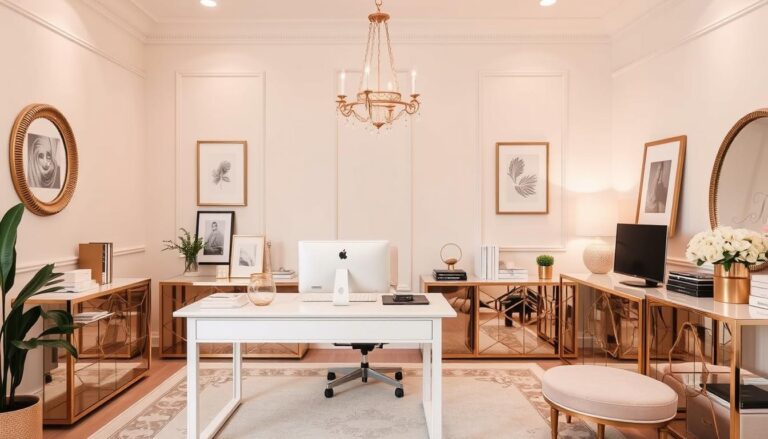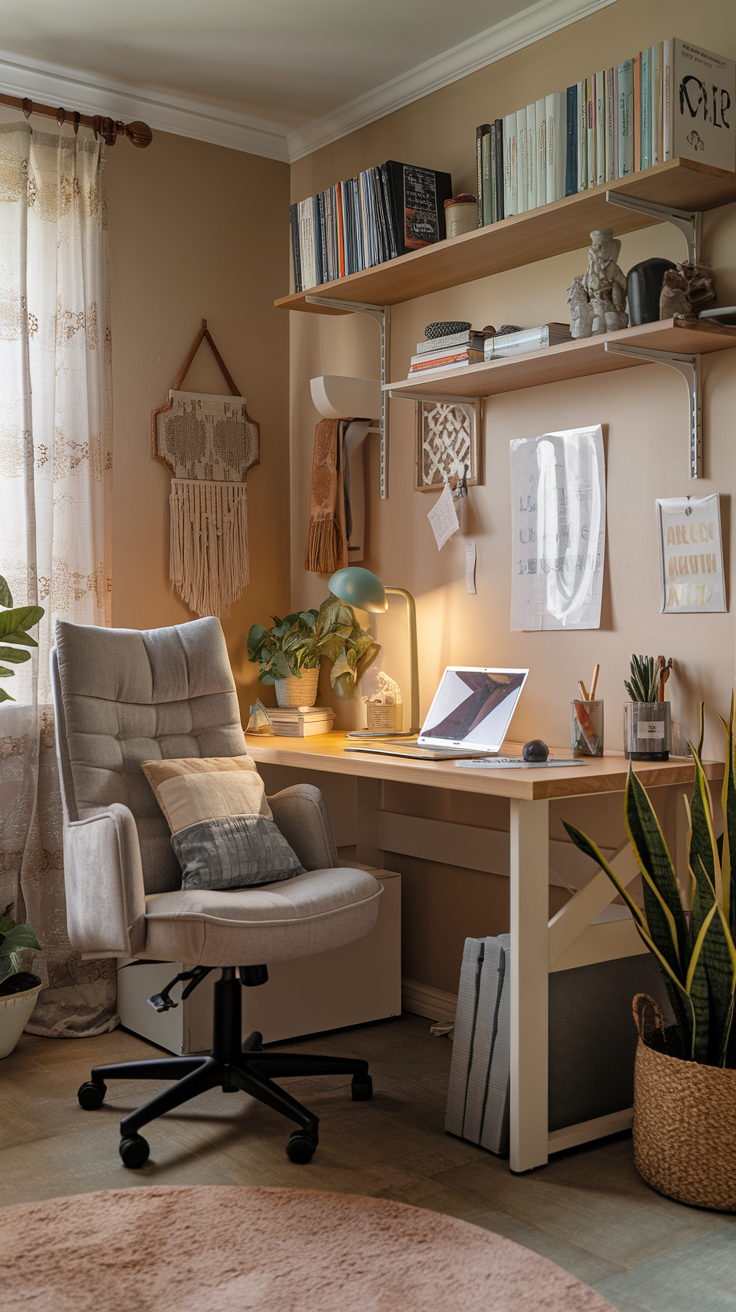The Secret to a Classy & Functional Workspace Revealed
Did you know 83% of professionals report feeling more motivated when their workspace balances elegance with practicality? A well-crafted environment isn’t just about aesthetics—it’s a productivity powerhouse that shapes how you think, create, and thrive.
Research shows thoughtful design choices—like prioritizing natural light or choosing an ergonomic desk—can boost creativity by up to 45%. Whether you’re refining a home office or revamping a corporate space, the intersection of form and function matters more than ever.
This guide focuses on three pillars: intentional layouts, lighting that adapts to your workflow, and personal touches that spark joy. You’ll learn how to curate items that serve both purpose and personality, transforming cluttered corners into inspiring hubs.
Designed for driven individuals who value substance over trends, these strategies blend neuroscience-backed principles with real-world adaptability. Let’s explore how to build an environment where productivity meets calm sophistication.
Key Takeaways
- Workspace design directly impacts creativity, focus, and emotional well-being
- Natural light and ergonomic furniture enhance both comfort and output
- Personalized elements increase connection to your environment
- Functional elegance benefits remote workers and office teams alike
- Simple changes create lasting improvements in daily work experiences
Understanding the Foundations of a Functional Workspace
Imagine starting your workday in an environment that feels both effortless and inspiring. A functional workspace isn’t just about looks—it’s a carefully curated ecosystem where every element supports your goals. Studies reveal workers in thoughtfully designed spaces experience 32% fewer distractions and 19% faster task completion.
Why Design Shapes Your Output
Lighting plays a starring role here. Researchers found offices with natural light exposure see 56% less eye strain complaints. Pair that with adjustable task lamps, and you create layers of illumination that adapt to brainstorming sessions or focused deep work.
Building Blocks for Better Work
- Ergonomic furniture that aligns with your body’s natural posture
- Decluttered surfaces to minimize visual noise
- Zones designated for specific tasks (creative thinking vs admin work)
A University of Texas study showed organized spaces boost problem-solving skills by 28%. It’s not about sterile minimalism—it’s creating intentional flow. Your desk becomes a launchpad rather than a obstacle course.
Consider how a well-placed plant or textured rug can soften a room’s acoustics while adding personality. These subtle touches prove functionality and warmth aren’t mutually exclusive—they’re partners in crafting spaces where great work happens.
The Secret to Creating a Classy Yet Functional Workspace
Ever notice how some workspaces feel effortlessly polished while handling heavy workloads? The magic lies in harmonizing visual charm with practical solutions that sustain daily use. Neuroscience research reveals environments blending artistry and ergonomic support increase task persistence by 34% compared to purely utilitarian setups.

Design Choices That Elevate Daily Work
Start with furniture that marries form and function. An adjustable chair with lumbar support becomes a style statement when paired with a minimalist desk in warm wood tones. Storage ottomans or floating shelves keep essentials nearby without sacrificing sleek lines.
Color psychology plays quiet hero here. Soft blues and greens promote calm focus, while metallic accents add refined energy. Layer these hues through removable decor like area rugs or framed art—flexible options that evolve with your needs.
Lighting deserves equal attention. A sculptural floor lamp near your seating area creates ambiance, while directed task lights prevent eye strain during detailed work. This layered approach helps create zones for different activities within one room.
Remember—small upgrades often yield big returns. Swap harsh overhead bulbs for dimmable LEDs. Add a leather desk organizer that keeps pens handy while elevating your setup’s sophistication. When every element serves dual purposes, your environment becomes both muse and tool.
Selecting the Perfect Location and Layout for Your Workspace
Where you place your desk matters more than you might think. A Cornell University study found employees in dedicated work areas with natural light showed 25% better concentration than those in shared spaces. Your environment’s physical setup acts as silent partner in your daily productivity.
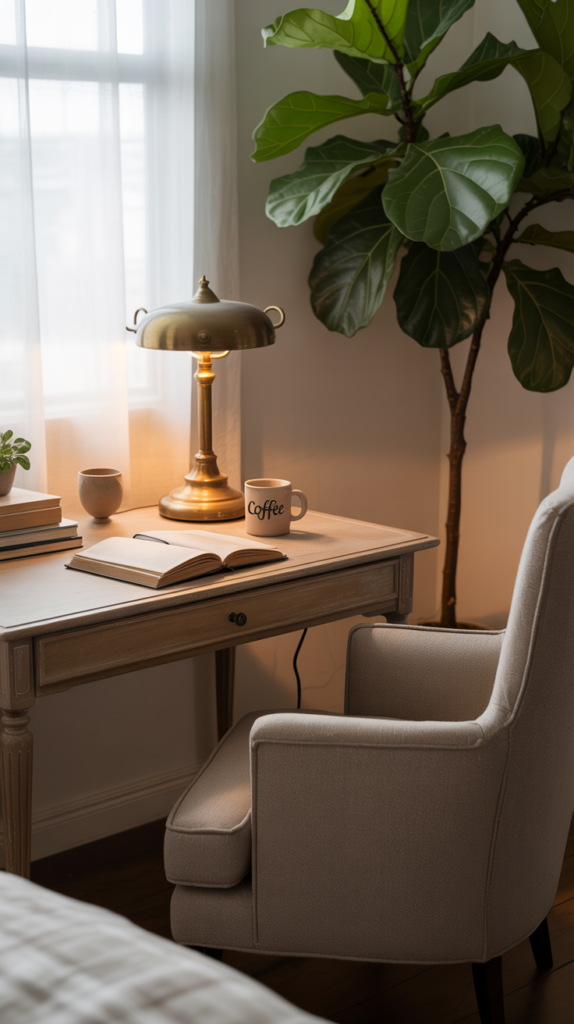
Carving Out Your Productivity Zone
Choose a quiet corner in your home office or apartment that feels separate from living zones. Even a well-defined nook creates mental boundaries—researchers note this physical separation helps 68% of remote workers disconnect after hours.
Position your desk near a window when possible. Morning sunlight regulates circadian rhythms while reducing screen glare. If your space lacks windows, place task lighting at 10 o’clock to minimize shadows during writing or video calls.
- Distance desks from high-traffic household areas like kitchens
- Ensure storage solutions sit within arm’s reach
- Use slim, functional stylish furniture to maximize smaller areas
An intentional layout transforms how you move through tasks. One interior design firm found clients who organized their workspace into activity zones completed projects 40% faster. Your desk becomes more than furniture—it’s the command center for focused work.
Maximizing Natural Light and Thoughtful Lighting Solutions
Light shapes more than what you see—it defines how you work and feel each day. Cornell University researchers found employees near windows report 25% fewer afternoon energy slumps. Meanwhile, Harvard Business Review notes layered lighting reduces headaches by 31% in office settings. Your environment’s glow isn’t just functional—it’s a mood architect.
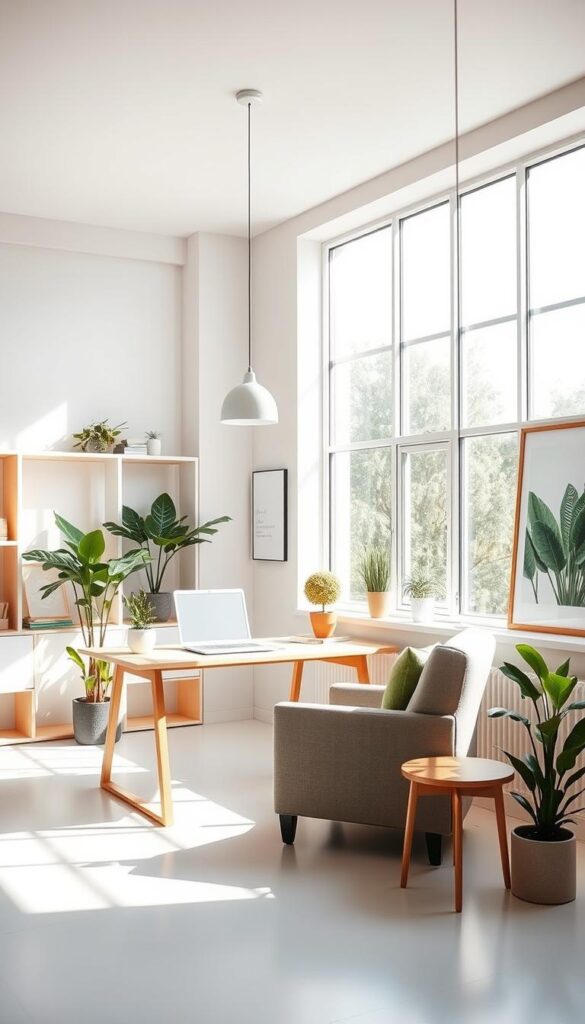
Harnessing Daylight’s Hidden Advantages
Position desks perpendicular to windows to minimize glare while bathing your workspace in soft illumination. Morning sun regulates cortisol levels, helping you tackle complex tasks early. If your office lacks windows, use full-spectrum bulbs that mimic natural wavelengths—studies show they improve alertness similarly to daylight.
Crafting Your Light Layers
Combine three types for optimal results:
- Ambient: Ceiling fixtures or wall sconces providing baseline brightness
- Task: Adjustable desk lamps with dimmers for detailed work
- Accent: Directional lights highlighting artwork or plants
This trifecta lets you shift from spreadsheet marathons to creative brainstorming without straining your eyes.
Smart Solutions for Visual Comfort
Try the 20-20-20 rule: every 20 minutes, look at something 20 feet away for 20 seconds under softer light. Warm-toned bulbs (2700K-3000K) ease evening screen time, while blue-light filters on devices protect circadian rhythms. For cozy home office ideas for small, consider plug-in pendants that add touch of elegance without permanent fixtures.
Leading tech firms now use biodynamic lighting that shifts color temperature throughout the day. While replicating this system isn’t essential, choosing versatile items like USB-powered LED strips lets you adapt as needs evolve. Remember—your lighting should work as hard as you do, just more quietly.
Ergonomic Furniture and Storage: Comfort Meets Functionality
Your chair isn’t just seating—it’s the foundation of productive hours. Research shows proper ergonomics reduces muscle fatigue by 41% while boosting focus. Pair supportive furniture with intelligent storage to craft a workspace that fuels both body and mind.
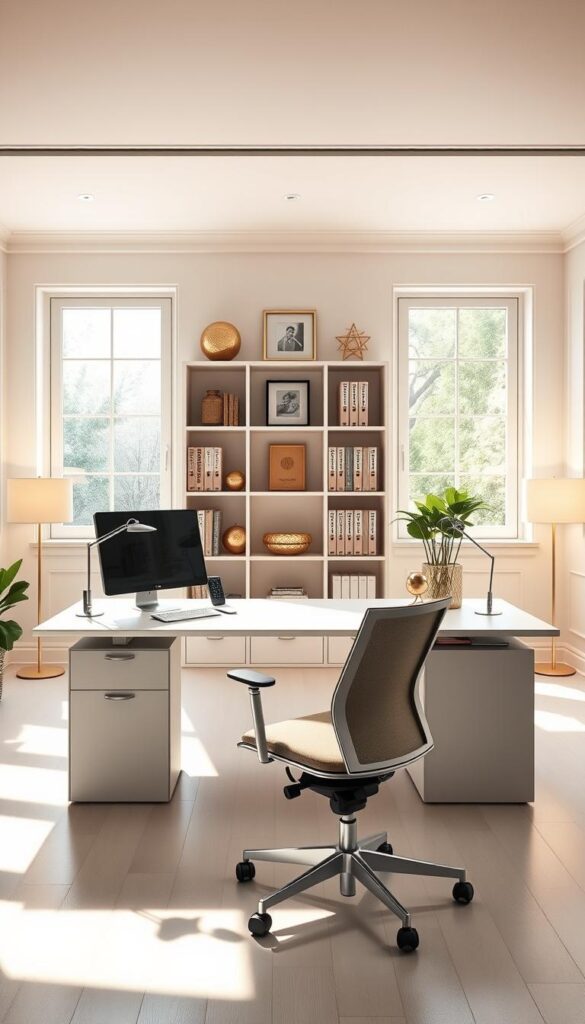
Investing in Supportive Chairs and Desks
An ergonomic chair adjusts to your body, not the other way around. Look for lumbar support matching your spine’s natural curve and armrests aligning with desk height. Brands like Officely design chairs with breathable mesh backs paired with height-adjustable desks—tools that marry comfort with minimalist style.
Smart Storage Solutions to Minimize Clutter
Clutter isn’t just visual noise—it costs the average worker 4.3 hours weekly searching for misplaced items. Sleek vertical drawers or wall-mounted shelves keep reference materials accessible yet hidden. Consider these features when organizing:
- Modular units that expand as needs change
- Closed cabinets for less-used supplies
- Desktop organizers with designated slots for tech
Well-designed storage solutions create mental space for creativity. A Stanford study found orderly environments improve cognitive function by 17%. Your home office becomes a sanctuary where every item has purpose and place.
Personalizing Your Workspace with Artistic Touches and Color Palettes
What if your desk could spark joy and focus simultaneously? Personalization transforms sterile areas into dynamic environments where creativity thrives. A University of London study found workers surrounded by meaningful decor complete tasks 27% faster while reporting higher satisfaction.
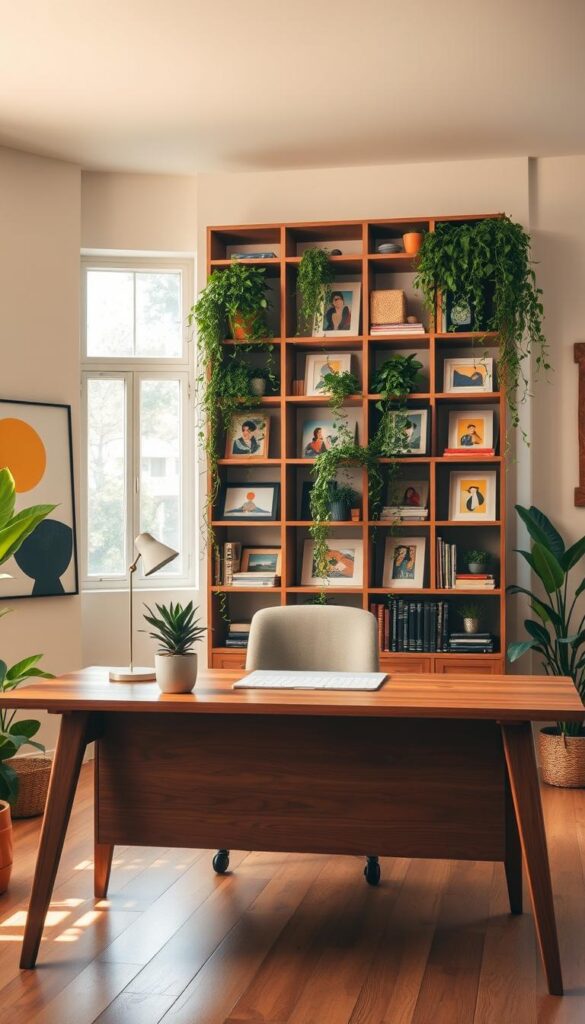
Curate Visuals That Speak to Your Process
Artwork acts as silent collaborators. Graphic designers often display abstract prints to fuel imagination, while writers might choose motivational quotes. Rotate pieces seasonally—a vibrant landscape in spring, muted abstracts in winter—to keep your mind engaged.
Color palettes work behind the scenes too. Soft teal walls lower cortisol levels, while ochre accents stimulate problem-solving. Try this approach:
- Dominant color (60%): Neutral base like warm gray
- Secondary colors (30%): Mid-tone blues or greens
- Accents (10%): Bold citrus or metallics
Nature’s Quiet Influence
NASA research shows certain plants remove 87% of airborne toxins within 24 hours. A snake plant near your monitor purifies air while adding organic texture. For those lacking green thumbs, preserved moss walls offer low-maintenance elements.
Creative director Maya Torres shares: “My fiddle-leaf fig became a meditation prompt—watering it each morning centers me before tackling emails.” Pair botanicals with natural materials like rattan baskets or stone coasters to deepen the calming effect.
These intentional touches do more than decorate—they create ecosystems where innovation flourishes. As you refine your workspace, remember: environments shaped with care shape us in return. For more ideas, explore this guide to designing a productive and stylish workspace.
Effective Decluttering and Organizational Strategies
Visual noise from piled papers and scattered supplies does more than annoy—it actively drains cognitive resources. Princeton Neuroscience Institute researchers found cluttered environments reduce focus by 29% while increasing stress hormones. Your workspace organization directly shapes how efficiently you tackle tasks.
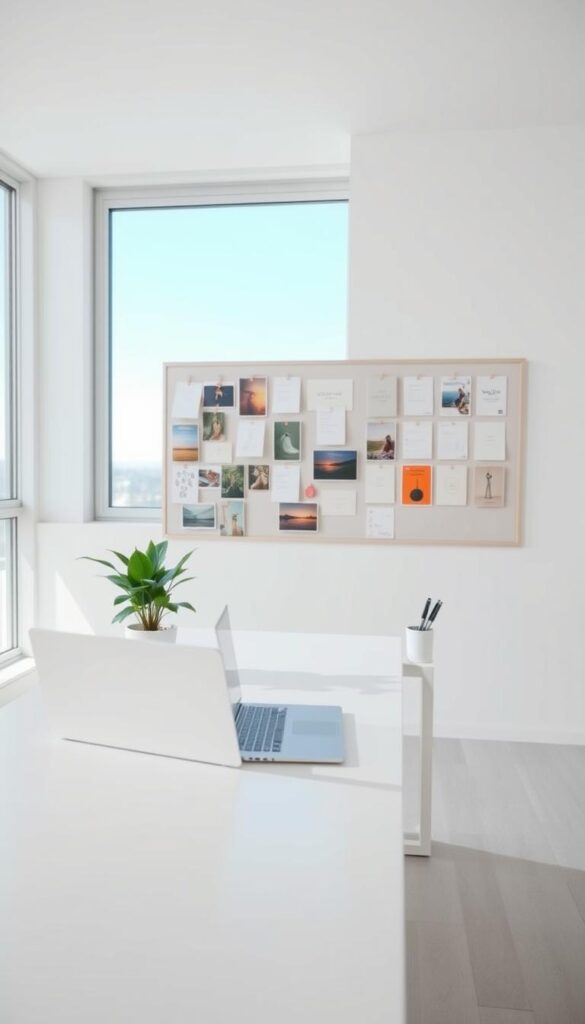
Designing an Efficient Layout to Enhance Productivity
Start with a five-minute daily reset. Return stray items to designated homes—pens in holders, chargers in labeled drawers. This habit prevents small messes from becoming overwhelming. Studies show those who maintain tidy desks spend 36% less time searching for tools weekly.
Invest in desk organizers that match your workflow. Vertical file holders keep reference materials accessible but contained. Try modular trays for frequently used devices—research proves having everything in reach cuts task-switching delays by 41%.
Rotate decor seasonally. Remove pieces that no longer inspire or serve purpose. Interior designers recommend the “one in, one out” rule: adding new storage solutions means retiring outdated ones. This approach helps keep workspace systems fresh and functional.
Finally, position your most-used tools within arm’s reach. Place printers or reference books slightly farther to encourage micro-movement breaks. These intentional choices help create environments where clarity thrives—proving order isn’t restrictive, but liberating.
Designing a Workspace That Boosts Well-being and Productivity
Clean air might be your most overlooked productivity partner. The WELL Building Standard reveals optimized indoor environments increase cognitive function scores by 26%—proving health-focused design isn’t just trendy, it’s transformative. Your workspace becomes a wellness engine when you address both breathable air and mental renewal spaces.
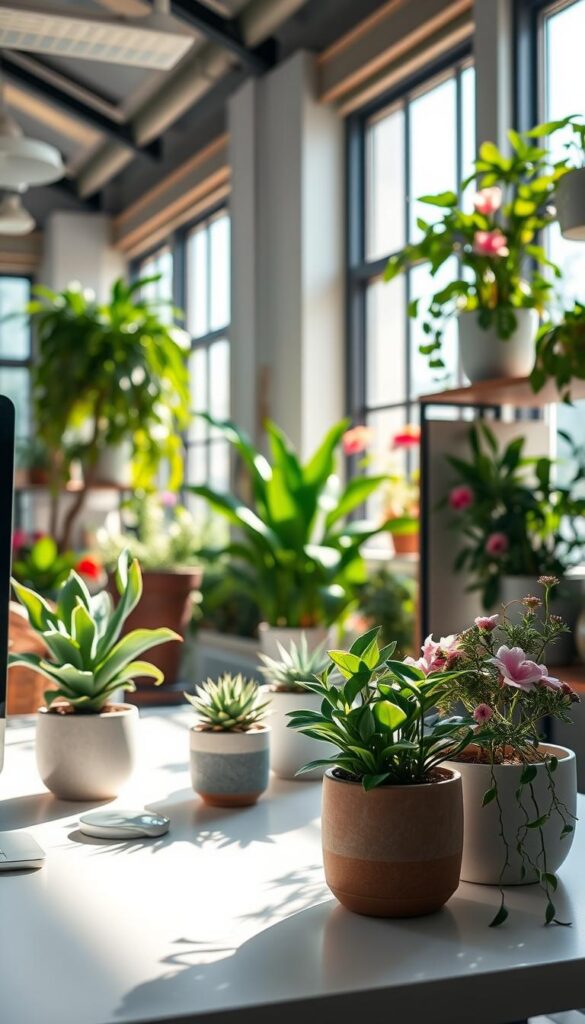
Breathing Room for Better Focus
Start with these air-quality enhancers:
- Plants like peace lilies that remove formaldehyde
- HEPA filters capturing 99.97% of airborne particles
- Low-VOC materials in furniture and paint
Tech giants like Apple use living walls in office designs, reducing sick days by 18%. Even small changes matter—a desktop bamboo palm subtly cleans your immediate environment while adding natural texture.
Sanctuaries Within Your Space
Designate a corner with a comfortable chair and soft lighting for mental resets. Employees at companies with relaxation zones report 22% higher afternoon focus levels. Try these elements:
- Noise-canceling headphones for quick meditation breaks
- A side table for herbal tea or hydration
- Inspirational reading material unrelated to work
Google’s nap pods and Salesforce’s mindfulness rooms prove stylish solutions boost both well-being and output. Your recharge area shouldn’t feel clinical—add a textured throw pillow or curved lamp to maintain functional stylish appeal.
Investing time in these elements pays dividends. A Harvard study found workers in health-optimized spaces solved problems 61% faster. Your mind and body will thank you—one clean breath and mindful pause at a time.
Creating a Classy Home Office for Everyday Success
Your home office holds untapped potential—it can energize morning routines and reflect your unique approach to work. Interior designers emphasize spaces blending personal flair with professional polish achieve 23% higher satisfaction rates among remote workers. The key lies in curating elements that serve dual purposes without sacrificing character.
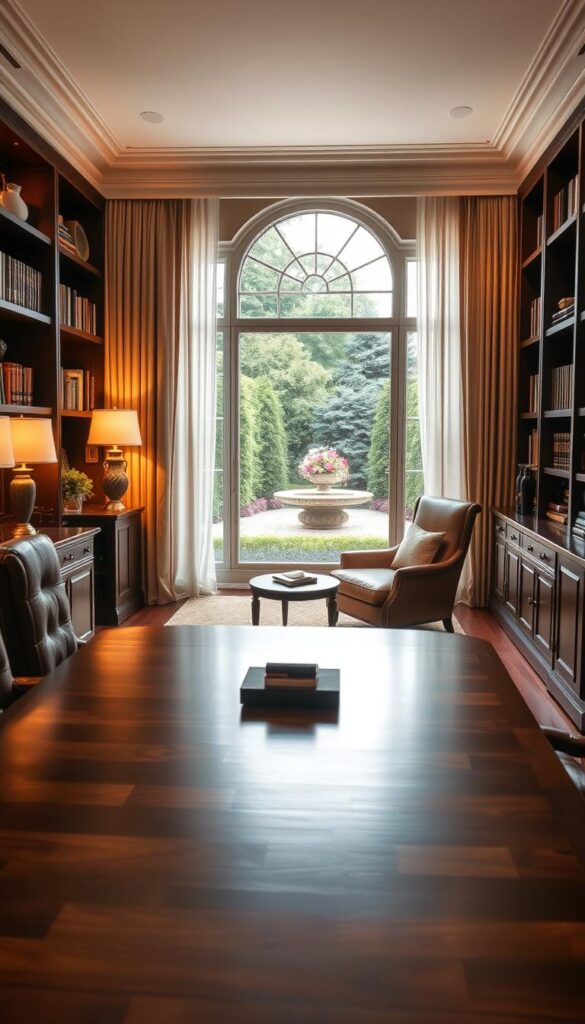
Harmonizing Style With Substance
Start by choosing a desk that anchors the room. A mid-century modern design with built-in drawers offers timeless appeal while hiding cords and supplies. Pair it with an ergonomic chair in neutral tones—flexible enough for video calls yet comfortable for long creative sessions.
Color choices quietly shape your mindset. Soft earth tones promote grounding during analytical tasks, while strategic pops of coral or sage green spark creativity. Framed artwork or family photos above your desk add personality without clutter.
- Modular storage units that adapt to changing projects
- Decorative trays corralling daily essentials stylishly
- Vertical shelves displaying books and meaningful objects
Tech consultant Rachel Nguyen transformed her spare room using this approach: “Woven baskets hide cables, while a vintage rug makes Zoom backgrounds pop.” Her hybrid space increased client bookings by 17% within three months.
Remember—your home office isn’t just where you work. It’s where ideas take shape. By balancing practical storage solutions with touches that inspire, you craft an environment where professional growth and personal expression thrive together.
Conclusion
Crafting an inspiring workspace transforms how you engage with daily tasks. Research confirms intentional design choices—like prioritizing natural light or selecting ergonomic chairs—directly enhance focus and creative output. These elements work together to build environments where productivity feels effortless rather than forced.
Remember: layered lighting reduces eye strain, while personalized decor fuels motivation. Smart storage solutions maintain visual calm, letting your mind tackle complex projects. Even small upgrades—a plant near your monitor or adjustable desk—create ripple effects in daily work experiences.
Start today by auditing one area of your office. Could better task lighting sharpen your focus? Would floating shelves free up desk real estate? Each adjustment moves you closer to a room that supports both professional growth and personal well-being.
For those seeking deeper insights, the strategies discussed here offer proven paths to balance elegance with practicality. Your ideal workspace isn’t a distant dream—it’s built through thoughtful, incremental changes that honor how you create best.
